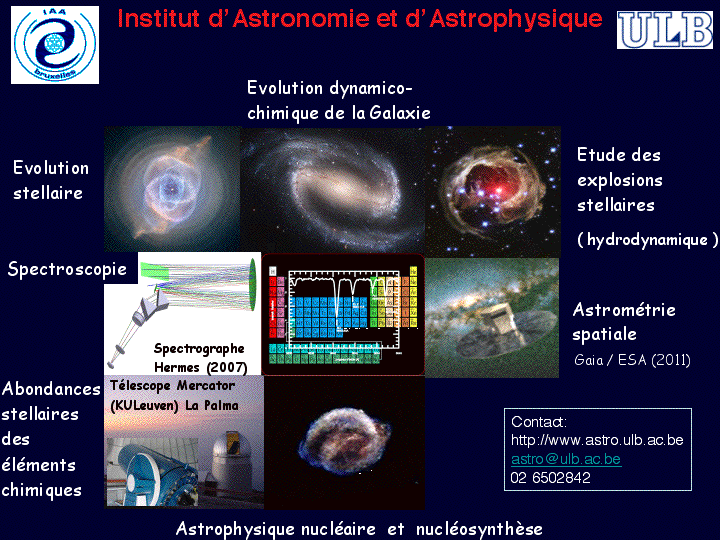Research at the Institute of Astronomy and Astrophysics
Our research interests cover various fields, among which nucleosynthesis, nuclear astrophysics, stellar evolution and chemical composition, binary stars, neutron stars...
Presentation
The IAA has grown quite remarkably during the last two decades. It is currently composed of one full professor, 5 tenured FNRS senior researchers, nine postdoctoral fellows from various countries (Belgium, France, Japan, United Kingdom), and two Ph.D. students.
The IAA staff members teach courses covering a broad range of matters from introductory astronomy to specialized topics.
Over the years, a coherent research strategy has been developed in the field of stellar physics. It involves observational studies (chemical composition of giant stars, binary properties, tomography of stellar atmospheres) that make use of the large ESO telescopes as well as of other major instruments. These observations are complemented and supported by theoretical studies of mass transfer in binary systems, of standard and non-standard stellar evolution (including the modelling of stellar hydrodynamical nuclear burning for application to certain thermonuclear supernovae) and of nuclear astrophysics (a field in which the IAA has long been recognized as an international centre of excellence), including the theory of nucleosynthesis. More recently the IAA has been carrying out research on the compact remnants of stellar evolution of massive stars: neutron stars.
Projects
With a strong involvement in the preparation of the Gaia mission from ESA, astrometry is by now an active research component of the IAA, through our implications in the Coordination Unit 4 (Object Processing) of the Gaia Data Processing and Analysis Consortium and the European Space Foundation network Gaia research for European Astronomy Training GREAT. Besides topics specific to Gaia, that preparation also includes the re-processing of the Hipparcos Intermediate data and a collaboration to the Sloan Digital Sky Survey.
Research in the field of extra-solar planets is also pursued, as well as the preparation and continued maintenance of the 9th catalog of spectroscopic binary orbits.
A variety of national and international collaborations have been set up in all the IAA research topics. It has also become recently a member of the HERMES consortium to build a high-resolution, high-efficiency spectrograph for the Mercator telescope at the Roque de los Muchachos Observatory (La Palma).
The Institute of Astronomy and Astrophysics is also involved in other research consortia including
- STAREVOL : the stellar evolution code used in Montpellier and Geneva observatories
- BINSTAR : the binary stellar evolution code developed at ULB
- PHAROS : the European Cooperation in Science and Technology (COST) action CA16214 The multi-messenger physics and astrophysics of neutron stars
- MESS : Mass-Loss of Evolved Stars, a Guaranteed Time Key Programme for the Herschel Space Observatory
- The HERMES consortium exploiting the HERMES spectrograph on the Mercator 1.2m telescope (KULeuven) at the Roque de los Muchachos Observatory (La Palma, Canary Islands)
- The STARLAB project
- The BISTRO Fed-tWIN project: The influence of binary stars on stellar and Galactic evolution, as revealed by current and large surveys
Research
In short
The research carried out at IAA focuses on stars and nucleosynthesis, both from the observational and theoretical points of view (a synopsis (in French) may be found HERE. The fields covered at IAA are the following:
- Nuclear Astrophysics: predictions of nuclear data of astrophysical interest.
- Compact Stars: our goal is to determine the properties of dense matter in these extreme astrophysical environments, and to constrain our microscopic models using both terrestrial experiments and astrophysical observations. Our recent works include unified equations of state of dense matter for which analytical representations are available.
- Stellar evolution : We develop and use our stellar evolution codes STAREVOL for single stars and BINSTAR for binary stars to study various aspects of the evolution and nucleosynthesis of stars over a wide range of masses, chemical compositions and evolutionary stages. Our research includes the study of rotational mixing, stellar hydrodynamics and s-process nucleosynthesis in low-, intermediate- and high-mass stars.
- High resolution spectroscopy, abundance determinations and the theory of stellar nucleosynthesis
- Multi-wavelength studies of chemically-peculiar red giant stars (Ba, S, C stars).
- Radial-velocity monitoring of Barium and S stars.
- A detailed study of the Henize sample of S stars.
- Tomography of the envelope of Mira stars: Synthetic spectra are used to construct synthetic masks to correlate with the observed spectra of Mira stars. The propagation of the shock wave through the photosphere is monitored through the evolution of the profile of the cross-correlation dips with time and depth in the atmosphere.
- Preparation of the Gaia mission: treatment of non-single objects (binary stars, star spots, exoplanets). Nice videos describing the Gaia mission may be found here.
- Kinematics of the solar neighbourhood as revealed by the Hipparcos satellite data.
In more details
The team has extensive expertise in the study of the nucleosynthesis of the elements heavier than iron by the so-called s-, r- and p-processes on the basis of parametric approaches as well as 1D and multi-dimensional stellar evolution models. The nuclear and astrophysics aspects of these three nucleosynthesis processes called for to explain the origin of the elements heavier than iron in the Universe are central in the research performed at the IAA.
As far as the nuclear aspects are concerned, the IAA has developed over the years an extended library of computed nuclear data of astrophysics relevance and made available to the scientific community. This library is referred to as BRUSLIB (BRUSsels LIBrary). The current public version includes thermonuclear reactions (nucleon and alpha-particle captures, photodisintegrations) calculated in the framework of the statistical Hauser-Fesbach approximation and the Direct Capture model. Various ingredients entering the rate calculations (masses, fission barrier, nuclear level densities, gamma strength functions and partition functions) are also provided apart from the reaction rates. This library presents the unique feature of being based as much as possible on a coherent set of microscopic nuclear-physics inputs in order to meet at best the demanding nucleosynthesis needs.
On the astrophysics side, one major theme of research concerns the study of stellar evolution. STAREVOL is the hydrodynamical stellar evolution code used at IAA and designed to follow the structural and chemical evolution of stars in the mass range 0.1-60 Msun from the pre-main sequence up to the end of Ne-burning, with emphasis on testing the predictions of nuclear astrophysics. It contains up-to-date internal physics in terms of nuclear reaction rates, neutrino loss rates and radiative opacities, and also in terms of the treatment of accretion, angular momentum transport, atomic diffusion, overshooting, semiconvection and thermohaline mixing, and shock waves. This code has recently been thoroughly modified to handle the simultaneous evolution of the two components of a binary system.
A third major theme of research at the IAA involves observations. Predictions from the above-mentioned stellar evolution and nucleosynthesis models are compared to observational data from the large ESO telescopes and from the HERMES spectrograph installed at La Palma (Canary Islands) by a consortium involving IAA (http://hermes.ster.kuleuven.ac.be). Targets observed with HERMES include metal-deficient stars (for abundance determinations and confrontation with model predictions for nucleosynthesis in the early Galaxy) and binary stars of various kinds (for orbit determination and correlation with their possibly peculiar abundance pattern resulting from mass transfer across the binary system). The team has extensive experience with the MARCS model atmospheres for computing synthetic spectra of cool stars and deriving precise abundances.
Space astrometry is by now an active research component of IAA, through its leadership of the Coordination Unit 4 (Processing on non-single objects) of the Gaia Data Processing and Analysis Consortium (DPAC) and its participation in the European Space Foundation network Gaia research for European Astronomy Training GREAT. IAA was involved as well in the Marie Curie Research Training Network European Leadership in Space Astrometry (ELSA), which has now ended. Workpackages assigned to IAA by DPAC/CU4 include the fully automatic fitting of eclipsing-binary lightcurves, and the assessment of the impact of stellar spots on the accuracy with which the stellar parallax can be derived by Gaia. In that framework, a monitoring of brigthness asymmetries at the surface of giant stars of different luminosities is carried out with the VISA/VLTI interferometer at ESO. The leadership of CU4/DPAC was awarded to IAA as a result of its recognised expertise in the field of binary stars. Similarly, the Radial Velocities commission of the International Astronomical Union has mandated IAA to update and maintain the 9th Catalogue of Spectroscopic Binary Orbits.
More recently, the study of compact stars has become another important research topic at the IAA. In particular, the IAA has been developing realistic equations of state of dense matter that could be applicable to various astrophysical environments: supernova cores, newly-born proto-neutron stars, cold isolated neutron star, accreting neutron stars, magnetars, but also magnetic and non-magnetic white dwarfs. Analytical representations of these equations of state are also available. These equations of state are based on the nuclear energy density functional theory, which has been already successfully applied to describe the structure and the dynamics of medium-mass and heavy atomic nuclei. This theory allows for a consistent treatment of both homogeneous and inhomogeneous phases, thus providing a unified description of all regions of neutron stars and supernova cores. Over the past years, the IAA has developed accurately calibrated semi-local nuclear energy density functionals fitted to essentially all experimental atomic mass data and constrained to reproduce realistic equations of state of neutron matter. We are also interested in nuclear superfluidity (microscopic properties and hydrodynamics) and its observational signatures like pulsar glitches. The IAA is currently involved in the European Cooperation in Science and Technology (COST) action CA16214 The multi-messenger physics and astrophysics of neutron stars PHAROS.
For the ADS publication lists of IAA staff members, go to the staff page



